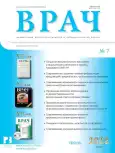Оценка взаимосвязи физико-химический показателей слюны, типа питания и качества питьевой воды
- Авторы: Саркисян Н.Г.1,2, Катаева Н.Н.1, Хохрякова Д.А.1, Меликян С.Г.1
-
Учреждения:
- Уральский государственный медицинский университет Минздрава России
- Институт иммунологии и физиологии Уральского отделения РАН
- Выпуск: Том 33, № 7 (2022)
- Страницы: 68-71
- Раздел: Из практики
- URL: https://journals.eco-vector.com/0236-3054/article/view/114657
- DOI: https://doi.org/10.29296/25877305-2022-07-14
- ID: 114657
Цитировать
Полный текст
Аннотация
Питьевая вода и продукты питания влияют на физико-химические свойства ротовой жидкости и интенсивность развития кариозных процессов. Цель. Оценить влияние продуктов питания и питьевой воды на некоторые физико-химические показатели смешанной слюны; охарактеризовать взаимосвязь свойств слюны и показателя интенсивности кариеса зубов. Материал и методы. В работе изучались следующие физико-химические свойства смешанной слюны: скорость саливации, водородный показатель, буферная емкость, поверхностное натяжение. Проводился анализ взаимосвязи этих показателей с типом питания, качеством питьевой воды и значениями индексов КПУ (сумма кариозных, пломбированных и удаленных постоянных зубов у обследуемого). Результаты. Выявлено, что такие характеристики питьевой воды, как рН и общая минерализация, соответствующие стандартам, поддерживают водородный показатель и буферную емкость слюны в пределах физиологической нормы. Показано, что частые перекусы и наличие в рационе обследуемых «липких» углеводов приводит к увеличению скорости саливации и понижению поверхностного натяжения слюны. Установлено, что исследуемые показатели слюны находятся в корреляции с индексом КПУ. Самые высокие значения индексов КПУ были определены у людей с низкими показателями рН, скорости саливации, буферной емкости по кислоте и высоким значением поверхностного натяжения слюны. Заключение. Качество питьевой воды и продуктов питания определяют особенности состава и свойств ротовой жидкости. Физико-химические показатели слюны влияют на интенсивность развития кариеса.
Ключевые слова
Полный текст
Об авторах
Н. Г. Саркисян
Уральский государственный медицинский университет Минздрава России; Институт иммунологии и физиологии Уральского отделения РАН
Email: kataeva.nn@mail.ru
доктор медицинских наук, профессор
Екатеринбург; ЕкатеринбургН. Н. Катаева
Уральский государственный медицинский университет Минздрава России
Автор, ответственный за переписку.
Email: kataeva.nn@mail.ru
кандидат химических наук, доцент
ЕкатеринбургД. А. Хохрякова
Уральский государственный медицинский университет Минздрава России
Email: kataeva.nn@mail.ru
Екатеринбург
С. Г. Меликян
Уральский государственный медицинский университет Минздрава России
Email: kataeva.nn@mail.ru
Екатеринбург
Список литературы
- Вавилова Т.П., Янушевич О.О., Островская И.Г. Слюна. Аналитические возможности и перспективы. М.: Бином, 2014; 312 с.
- Водоробот: Екатеринбург и область [Электронный ресурс]. URL: https://www.vodorobot.ru/ekb/quaHty.html
- Рейтинг качества питьевой воды в районах Екатеринбурга [Электронный ресурс]. URL: https://www.xn--80aadbki6adhshb.xn--p1ai/
- Еловикова Т.М., Григорьев С.С. Слюна как биологическая жидкость и ее роль в здоровье полости рта. Екатеринбург: ИД «ТИРАЖ», 2018; 69 с.
- Микаелян Н.П., Комаров О.С., Давыдов В.В. и др. Биохимия ротовой жидкости в норме и при патологии. Учебно-методическое пособие для самостоятельной работы студентов по специальности «Стоматология». М.: Издательство ИКАР, 2017; 64 с.
- Лаптева К.А., Бельтюкова И.А., Шабалина Д.С. и др. Изменение физико-химических показателей смешанной слюны под действием углевод-содержащих продуктов и их роль в формировании кариеса. Актуальные вопросы современной медицинской науки и здравоохранения. Мат-лы II Междунар. (72 Всеросс.) научно-практ. конф. молодых ученых и студентов, II Всеросс. форума мед. и фармацевт. вузов «За качественное образование», Екатеринбург, 12-14 апреля 2017 года. Екатеринбург: Уральский государственный медицинский университет, 2017; с. 159-62.
Дополнительные файлы






